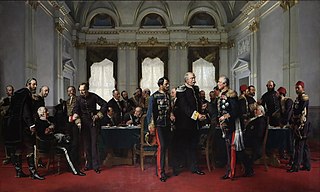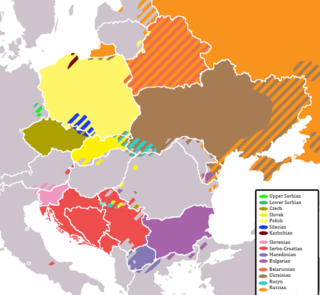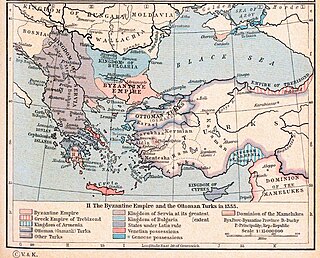
Pan-Slavism, a movement that took shape in the mid-19th century, is the political ideology concerned with promoting integrity and unity for the Slavic people. Its main impact occurred in the Balkans, where non-Slavic empires had ruled the South Slavs for centuries. These were mainly the Byzantine Empire, Austria-Hungary, the Ottoman Empire, and Venice.

The League of the Balkans was a quadruple alliance formed by a series of bilateral treaties concluded in 1912 between the Eastern Orthodox kingdoms of Greece, Bulgaria, Serbia and Montenegro, and directed against the Ottoman Empire, which at the time still controlled much of Southeastern Europe.

The Congress of Berlin was a diplomatic conference to reorganise the states in the Balkan Peninsula after the Russo-Turkish War of 1877–78, which had been won by Russia against the Ottoman Empire. Represented at the meeting were Europe's then six great powers: Russia, Great Britain, France, Austria-Hungary, Italy, and Germany; the Ottomans; and four Balkan states: Greece, Serbia, Romania and Montenegro. The congress concluded with the signing of the Treaty of Berlin, replacing the preliminary Treaty of San Stefano that had been signed three months earlier.

Georg Ritter von Schönerer was an Austrian landowner and politician of the Austro-Hungarian Monarchy active in the late 19th and early 20th centuries. A major exponent of pan-Germanism and German nationalism in Austria as well as a radical opponent of political Catholicism and a fierce antisemite, Schönerer exerted much influence on the young Adolf Hitler. He was known for a generation as the most radical pan-German nationalist in Austria.
Anti-Slavic sentiment, also known as Slavophobia, a form of ethnic based prejudice or xenophobia, refers to various negative attitudes towards Slavic peoples, the most common manifestation a claim that inhabitants of Slavic nations are inferior to other ethnic groups. Anti-Slavism reached its peak during World War II, when Nazi Germany declared Slavs, especially neighboring Poles to be subhuman (Untermensch) and planned to exterminate the majority of Slavic people.

Austro-Slavism or Austrian Slavism was a political concept and program aimed to solve problems of Slavic peoples in the Austrian Empire. It was most influential among Czech liberals around the middle of the 19th century. First proposed by Karel Havlíček Borovský in 1846, as an opposition to the concept of pan-Slavism, it was further developed into a complete political program by Czech politician František Palacký. Austroslavism also found some support in other Slavic nations in the Austrian Empire, especially the Poles, Slovenes, Croats and Slovaks.

Karel Kramář was a Czech politician. He was a representative of the major Czech political party, the Young Czechs, in the Austrian Imperial Council from 1891 to 1915, becoming the party leader in 1897.

Sergei Dmitryevich Sazonov GCB was a Russian statesman and diplomat who served as Foreign Minister from November 1910 to July 1916. The degree of his involvement in the events leading up to the outbreak of World War I is a matter of keen debate, with some historians putting the blame for an early and provocative mobilization squarely on Sazonov's shoulders, and others maintaining that his chief preoccupation was "to reduce the temperature of international relations, especially in the Balkans".

The powder keg of Europe or Balkan powder keg was the Balkans in the early part of the 20th century preceding World War I. There were many overlapping claims to territories and spheres of influence between the major European powers such as the Russian Empire, the Austro-Hungarian Empire, the German Empire and, to a lesser degree, the Ottoman Empire, the United Kingdom and the Kingdom of Italy.

Greater Croatia is a term applied to certain currents within Croatian nationalism. In one sense, it refers to the territorial scope of the Croatian people, emphasising the ethnicity of those Croats living outside Croatia. In the political sense, though, the term refers to an irredentist belief in the equivalence between the territorial scope of the Croatian people and that of the Croatian state.
Pan-nationalism is a specific term, used mainly in social sciences as a designation for those forms of nationalism that aim to transcend traditional boundaries of basic or historical national identities in order to create a "higher" pan-national (all-inclusive) identity, based on various common denominators. Pan-nationalism can occur as a specific variant of all common forms of nationalism. In relation to classical state nationalism, pan-nationalism manifests itself through various political movements that advocate the formation of "higher" (pan-national) forms of political identity, based on a regional or continental grouping of national states. In terms of ethnic nationalism, pan-nationalism can also manifest itself through specific ethnic movements that advocate setting up "higher" (pan-national) forms of common identity that are based on ethnic grouping. Other forms of nationalism also have their pan-national variants.

Alois Leopold Johann Baptist Graf Lexa von Aehrenthal was diplomat from the Austro-Hungarian Empire. Biographer Solomon Wank says he exuded a strong monarchical-conservative outlook, loyalty to the Empire, and optimism regarding its ability to survive and flourish in the early 20th century. He is best known for promoting an energetic foreign policy in the Balkans, seeking cooperation with Russia and approval of Germany for actions that angered the South Slav element in the Balkans.
The Serb-Catholic movement in Dubrovnik was a cultural and political movement of people from Dubrovnik who, while Catholic, declared themselves Serbs, while Dubrovnik was part of the Habsburg-ruled Kingdom of Dalmatia in the 19th and early 20th centuries. Initially spearheaded by intellectuals who espoused strong pro-Serbian sentiments, there were two prominent incarnations of the movement: an early pan-Slavic phase under Matija Ban and Medo Pucić that corresponded to the Illyrian movement, and a later, more Serbian nationalist group that was active between the 1880s and 1908, including a large number of Dubrovnik intellectuals at the time. The movement, whose adherents are known as Serb-Catholics or Catholic Serbs, largely disappeared with the creation of Yugoslavia.

Serbian nationalism asserts that Serbs are a nation and promotes the cultural and political unity of Serbs. It is an ethnic nationalism, originally arising in the context of the general rise of nationalism in the Balkans under Ottoman rule, under the influence of Serbian linguist Vuk Stefanović Karadžić and Serbian statesman Ilija Garašanin. Serbian nationalism was an important factor during the Balkan Wars which contributed to the decline of the Ottoman Empire, during and after World War I when it contributed to the dissolution of the Austro-Hungarian Empire, and again during the breakup of Yugoslavia and the Yugoslav Wars of the 1990s.

Macedonian nationalism is a general grouping of nationalist ideas and concepts among ethnic Macedonians that were first formed in the late 19th century among separatists seeking the autonomy of the region of Macedonia from the Ottoman Empire. The idea evolved during the early 20th century alongside the first expressions of ethnic nationalism among the Slavs of Macedonia. The separate Macedonian nation gained recognition after World War II when the "Socialist Republic of Macedonia" was created as part of Yugoslavia. Macedonian historiography has since established links between the ethnic Macedonians and various historical events and individual figures, which range from the Middle Ages up to the 20th century. Following the independence of the Republic of Macedonia in the late 20th century, issues of Macedonian national identity have become contested by the country's neighbours, as some adherents to aggressive Macedonian nationalism, called Macedonism, hold more extreme beliefs such as an unbroken continuity between ancient Macedonians, and modern ethnic Macedonians, and views connected to the irredentist concept of a United Macedonia, which involves territorial claims on a large portion of Greece and Bulgaria, along with smaller regions of Albania, Kosovo and Serbia.
Below is a list of the forms of Slavic nationalism.

Yugoslavism, Yugoslavdom, or Yugoslav nationalism is an ideology supporting the notion that the South Slavs, namely the Bosniaks, Croats, Macedonians, Montenegrins, Serbs and Slovenes, but also Bulgarians, belong to a single Yugoslav nation separated by diverging historical circumstances, forms of speech, and religious divides. During the interwar period, Yugoslavism became predominant in, and then the official ideology of the Kingdom of Yugoslavia. There were two major forms of Yugoslavism in the period: the regime favoured integral Yugoslavism promoting unitarism, centralisation, and unification of the country's ethnic groups into a single Yugoslav nation, by coercion if necessary. The approach was also applied to languages spoken in the Kingdom. The main alternative was federalist Yugoslavism which advocated the autonomy of the historical lands in the form of a federation and gradual unification without outside pressure. Both agreed on the concept of National Oneness developed as an expression of the strategic alliance of South Slavs in Austria-Hungary in the early 20th century. The concept was meant as a notion that the South Slavs belong to a single "race", were of "one blood", and had shared language. It was considered neutral regarding the choice of centralism or federalism.

A pan-Slavic language is a zonal auxiliary language for communication among the Slavic peoples.

History of modern Serbia or modern history of Serbia covers the history of Serbia since national awakening in the early 19th century from the Ottoman Empire, then Yugoslavia, to the present day Republic of Serbia. The era follows the early modern history of Serbia.

The First Serbian Volunteer Division or First Serbian Division, was a military formation of the First World War, created by Serbian Prime Minister Nikola Pašić, and organised in the city of Odessa in early 1916. This independent volunteer unit was primarily made up of South Slav Habsburg prisoners of war, detained in Russia, who had requested to fight alongside the Serbian Army. It also included men from South Slav diaspora communities, especially the United States.

















